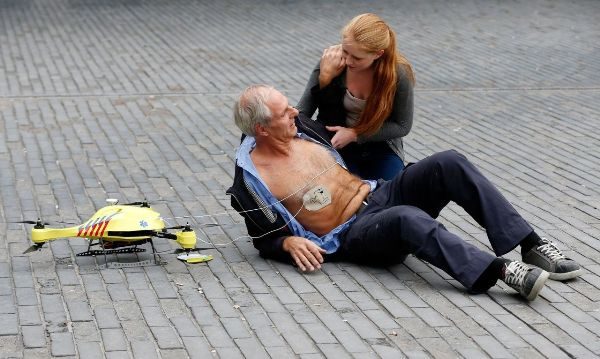Yep, here it comes to save the day! Alec Momont, a graduate student at Delft University of Technology (TU Delft) in the Netherlands, created the Ambulance Drone project. Their intent was to develop a drone that would deliver life-saving equipment like an Automated External Defibrillator (AED), medicines, and Cardiopulmonary Resuscitation (CPR) aids to the scene of an emergency. The first drone prototype focused on delivering an AED. They created a compact, lightweight drone (using 3-D printed microstructures and a carbon fiber frame) that flies 100 kilometers per hour and reduces the average emergency response time from 10 minutes to one minute (in the European Union).
According to the American Heart Association,
Immediate cardiopulmonary resuscitation (CPR) and early defibrillation, with an automated external defibrillator (AED), can more than double a victim’s chance of survival. In fact, early defibrillation, along with CPR, is the only way to restore the victim’s heart rhythm to normal in a lot of cases of cardiac arrest. For every minute that passes without CPR and defibrillation, however, the chances of survival decrease by 7–10%. A recent study sponsored in part by the National Institutes of Health and the American Heart Association shows that most cardiac arrests that occur in public places are “shockable” arrhythmias or those that respond to a shock from an AED, making AEDs in public places highly valuable. Yet, there are not enough AEDs and persons trained in using them and performing CPR to provide this lifesaving treatment, resulting in lost opportunities to save more lives.
Hopefully, drones like this one will turn those lost opportunities into life-saving events because the developers incorporated “a two-way, video supported, communication channel in the drone” that allows the 1-1-2 emergency operator and the person there at the scene to communicate. The emergency operator is then able to provide step-by-step instructions on how to use the AED.
Where are they at in development? According to TU Delft, “The complex nature of a systems innovation like this makes commercial exploitation, not an easy task. TU Delft is considering further steps in the development.”
Watch the video to see how it works:
You can read more about the Ambulance Drone project here


![No Registration Needed - Under 249 g, this drone with camera for adults 4K does not require FAA registration or Remote ID for recreational use. Visit the FAA's official website for requirements related to drone registration and Remote ID. [1] 4K Ultr...](https://m.media-amazon.com/images/I/31yhwXPlaNL._SL160_.jpg)
